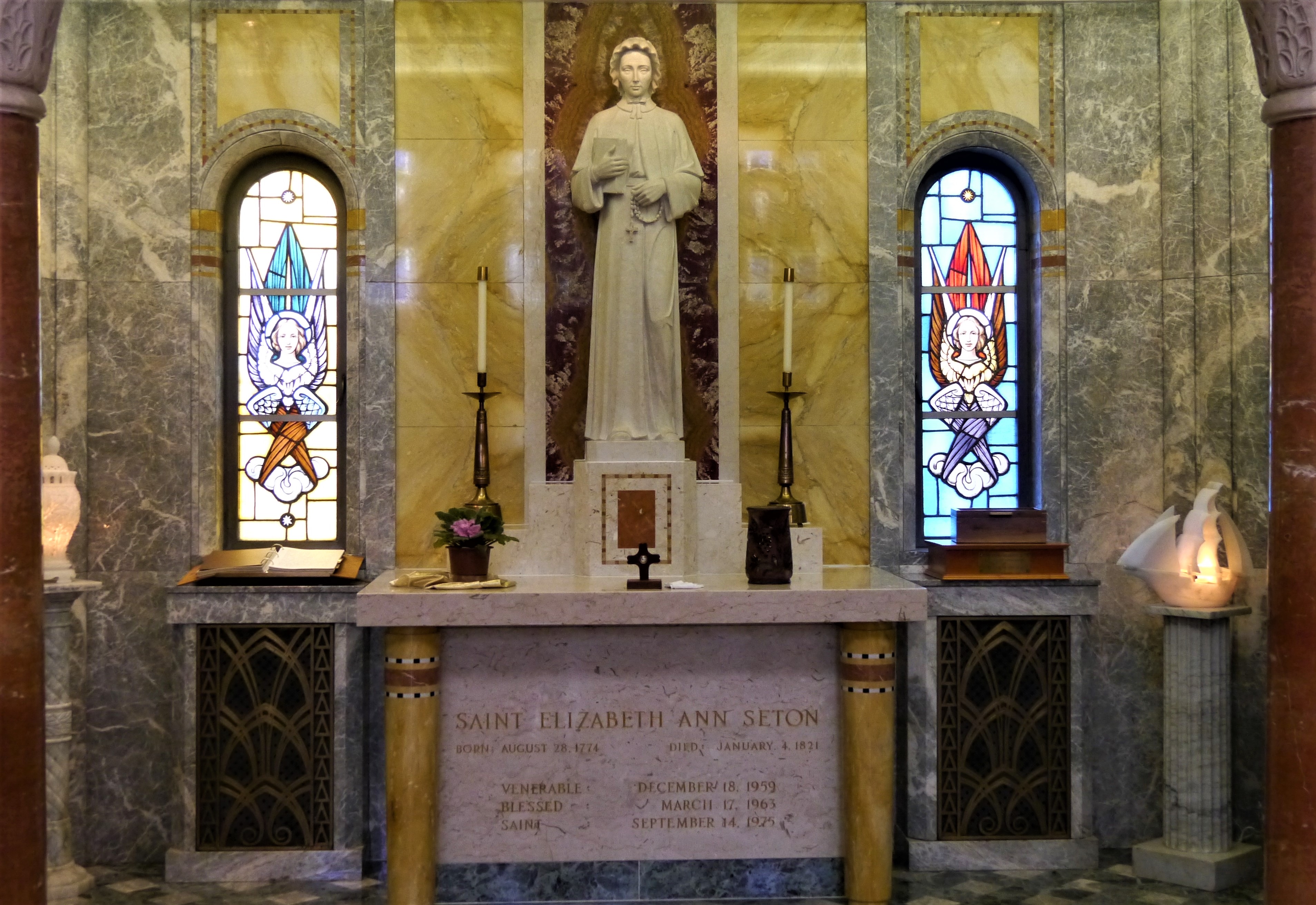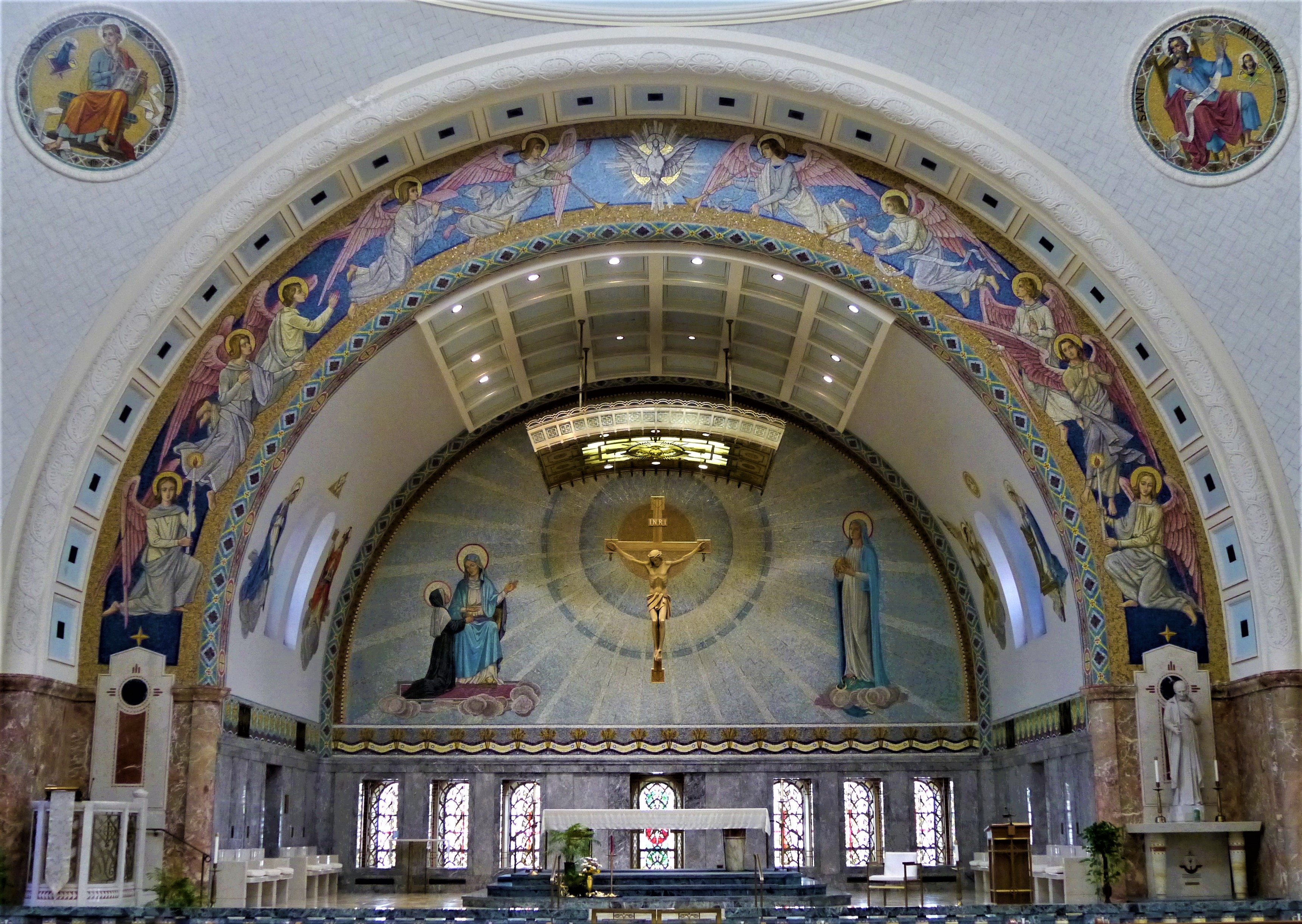
Rural north Maryland was the unlikely home of a remarkable daughter of God, Elizabeth Ann (nee Baley) Seton; the first canonized American saint of the Catholic Church. Born two years before the American Revolution, daughter of a wealthy and socially connected doctor in New York, wife of a wealthy shipping magnate, mother of five, widow, and convert from the Episcopal Church (grandfather was rector of St. Andrews) to the Catholic faith after the passing of her husband while they were in Italy.
From early on Elizabeth had an ongoing connection with God as demonstrated by her remembrance of a day when she was fourteen years old:
”found an outlet in a meadow; and a chestnut tree with several young ones growing around it, found rich moss under it and a warm sun. Here, then, was a sweet bed -the air still a clear blue vault above-the numberless sounds of spring melody and joy the sweet clovers and wildflowers I had got by the way, and a heart as innocent as human heart could be, filled even with enthusiastic love to God and admiration of His works …. God was my Father, my all. I prayed, sang hymns, cried, laughed, talking to myself of how far He could place me above all sorrow. Then I laid still to enjoy the heavenly peace that came over my soul; and I am sure, in the two hours so enjoyed, grew ten years in the spiritual life …. The wintry storms of time shall be over and the unclouded spring enjoyed forever.”
This was a special memory, but her conversations with, and faith in God were a constant in her life. Every loss, every sorrow found consolation in her connection with her Lord.
During the last days of her husband’s life who was suffering from T.B., imprisoned in an Italian quarantine area, with no heat, locked in a cell because they had just disembarked from a ship from New York that had an epidemic of Yellow Fever, she drew her strength and comfort from God, for she had no other:
“WeIl, I was alone; dear indulgent Father! Could I be alone while clinging fast to Thee in continual prayer or thanksgiving, prayer for him and joy, wonder and delight to feel assured that what I had so fondly hoped and confidently asserted really proved in the hour of trial to be more than I could hope, more than I could conceive? That my God could and would bear me through the most severe trials with that strength, confidence and affiance which, if every circumstance of the case was considered, seemed more than a human being would expect or hope? But His consolations, who shall speak of them? How can utterance be given to that which only his spirit can feel?”
After the death of her husband, and while still the guest of a wealthy Italian family, friends of her husband and now her friends as well, she was taken with the eucharist ceremony, differing from the Protestant conception of communion in that the wafer and wine are actually converted into the body and blood of the living Christ. Elizabeth struggled with the idea, but God seemed intent on opening up this reality to her sincere search for God:
February 24.
How happy we would be if we believed what these good souls believe …When they carry the Blessed Sacrament under my window, while I feel the full loneliness and sadness of my case I cannot stop the tears at the thought …. The other day in a moment of excessive distress, I fell on my knees without thinking, when the Blessed Sacrament passed by, and cried out in an agony to God to bless me, if He was really there, that my soul desired only Him.
On her return to New York the family did not take well to Elizabeth’s conversion. In part it was family history. They were Huguenots, protestants persecuted by the majority Catholic population of France precipitating their move to the religious freedom of the colonies. Also, at the time in New York, being Catholic was associated with poor Irish immigrants, and there was discrimination and even violence against the Irish and their priests. The Seton family became even more enraged when Elizabeth’s 15 year old sister-in-law converted as well.
As a result of their withdrawal of support, Elizabeth, and children, went from socialite to impoverishment, from connections in society to being shunned, from protection of a powerful family to being on her own. One source of support was her husband’s previous business associates from Italy who directed their bank to advance Elizabeth funds, which she only drew upon when absolutely needed for her family. She attempted to start a school, but was torpedoed by the Seton family and the minister of the Episcopal Church; Elizabeth’s prior spiritual advisor.
Her plight was seen however, by those in the Catholic hierarchy and she was offered a position in Baltimore, and so the move of her family took her there. She was asked to lead a group inspired by the Daughters of Charity, an order from France that was connected with the work of St. Vincent De Paul. She took vows, and brought her children and now two sisters-in-law with her. She became Mother Seton, head of the order of Sisters of Charity; education and service to those in need was their mission. The school and growing list of sisters were given a home and acreage in Emmitsburg Maryland. Several of her daughters succumbed to T.B., and so eventually did Elizabeth at age 46. She created a network of sisters in education, care for orphans and those in need.
We visited the magnificent Basilica where her bones are kept, and was given a tour of the grounds which included her first school house and the “white house,” built later to accommodate the growing number of sisters and students. She promoted a novel idea of free education for those who could not afford it. There was no effort to convert protestant students, all were treated equally. She was also not in favor of corporal punishment, she disciplined with love. Mother Seton had a special veneration for St. Joseph. Saint Seton was canonized in 1975.
Visiting the Basilica a day after Gettysburg, we felt a spiritual baptism that washed away the suffering we had continued to feel from those battlegrounds and its history. It is easy to think of Mother Seton and Mother Hamilton as kindred spirits. Both were married, loved their children, both had T.B. (Mother’s was healed by her guru, Swami Yogananda), both disciplined with love, had very strong wills, bucked their families intense desires that they remain in the own church, and both were strong women who pioneered new pathways to God. It was a blessing to have her darshan.
Carla on Mother Seton–The Power of a Saint
Going to see a where a saint lived and worked is a highlight for me in this pilgrimage. I just happened to see a billboard that advertised the “Seton Basilica and home of a saint,” and of course, what else could be better than to go and visit.
After a tour of the grounds and Mother Seton’s home and teaching areas, we hurried up to the basilica before they closed–I was awed by the magnificent Light-filled space. The physical beauty was inspiriting and one of the most lovely churches I have ever seen. A volunteer said that Mother Seton was buried along the far side of the church, and that there was a relic (a bone) of hers that was on the alter. It reminded me of Anandashram and the special opportunity to touch Papa’s bones on the altar there.
I walked over and touched the wooden carving where the bone was kept underneath and immediately felt a very powerful spiritual charge. It was a delightful and surprising gift after hearing about her life and all the wonderful things she had done. The information they gave about her was interesting, but felt more like reading a biography. But, when I touched the altar I was clearly shown that this was a great God-woman. I sat for as long as they allowed (too short, but God arranged it perfectly) and just melted into that powerful feeling of love and bliss.
It felt like a huge spiritual waterfall of healing that continues to fill me with such gratitude to God, Gurus and Saints. You never know how, when, and where God will direct you so that His Grace and love can be seen, and most of all felt and experienced!

